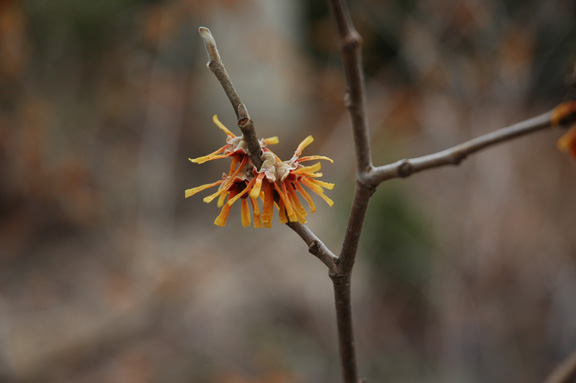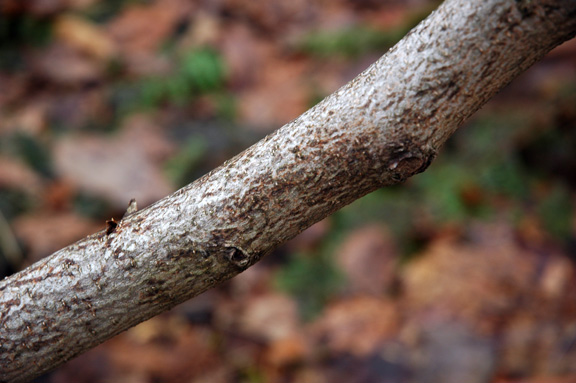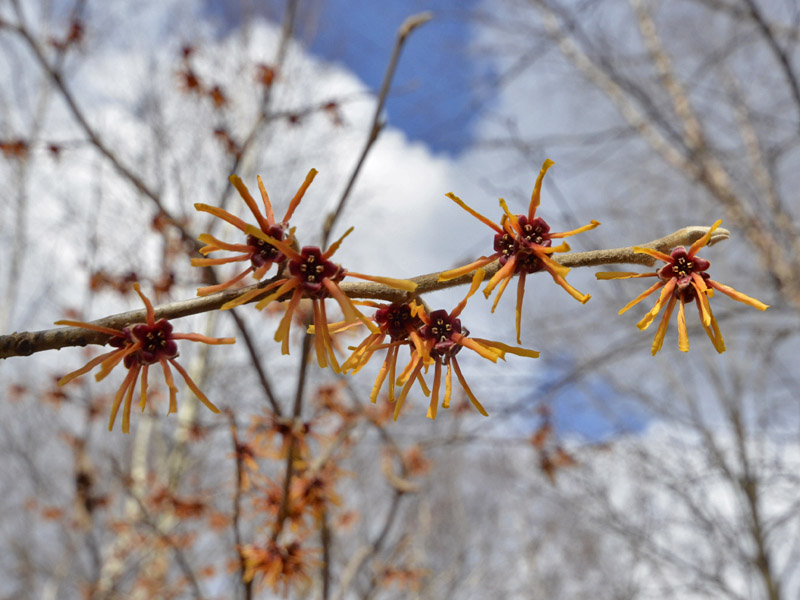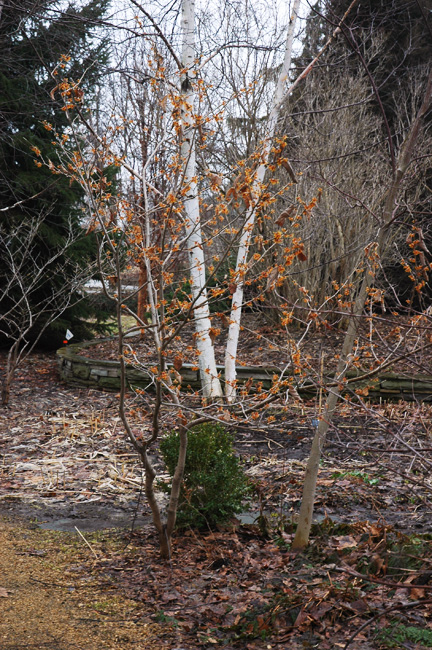| General Description | ‘Jelena’ is a large, deciduous shrub or small tree. During bloom the copper coloured flowers produce a sweet scent. The foliage develops into spectacular red and orange tones in autumn. |
| ID Characteristic | Three prominent, key identification characteristics of this plant are: the unique, copper coloured flowers it produces in very early spring, its scent and the deeply veined leaves that are typical of the species. |
| Shape | Tiered, multi-stemmed. It is an upright oval shrub when young and becomes wide-spreading towards maturity. |
| Landscape | Jelena is highly regarded for its winter flowering character. The flowers resemble the shape of a spider (the body being dark red, with remarkable coppery tones for legs). When it flowers in February the blooms stand out on branches in clusters, surviving frost and thus persisting for quite some time. Although it is a remarkable sight in the winter, 'Jelena' is equally valuable in autumn and the summer months. In autumn, the leaves turn brilliant shades of orange-red in autumn but remain fresh, bright, t attractive green in summer; making it a multi-seasonal specimen. It contrasts well in the landscape next to vertical stems (Cornus alba and relatives) due to its tiered branching habit. It also serves well as a woodland edge, a winter border plant, or is suited to placement near entrances, patios, and windows, where the scent of the flowers can be appreciated. |
| Propagation | H. xintermedia ‘Jelena’ can be propagated through softwood cuttings, or it can be grafted in the winter. When propagating via softwood cuttings, keep cuttings moist for 8-10 weeks, with bottom heat of 20°C either under mist or in a high humidity environment until well rooted, transplant into individual containers to grow on. Otherwise, grafting takes place onto the rootstock of Hamamelis virginiana. |
| Cultivation | Plant this cultivar in spring or mid-autumn in full sun to partial shade in moist, fertile soil. It prefers acidic conditions but is adaptable to a neutral to slightly alkaline pH. It must not be crowded and should be planted where it can develop its f broad-spreading form. Out of place, crossing stems and suckers on grafted plants should be removed in early spring. |
| Pests | Relatively none too serious. The presence of Japanese Beetles may be evident on some leaves depending on beetle populations. |
| Notable Specimens | Chris Lane, who has written a book called “Witch Hazels”, (often referred to as the “witch hazel bible”) owns a Nursery with a collection of over 500 witch hazel cultivars and species on display. These plants can only be viewed by appointment (with the exception of some open house days). The Witch Hazel Nursery is located in Newington, Sittingbourne, in the United Kingdom. Another location to view this plant is the A.M Cuddy Gardens, Strathroy, Ontario, Canada. |
| Habitat | Horticultural origin. |
| Bark/Stem Description | The bark is grey-brown is smooth with visible lighter brown lenticels but is of little ornamental interest. |
| Flower/Leaf Bud Description | Pubescent or 'fuzzy', rounded, light brown and are approximately 2 cm in length. |
| Leaf Description | The leaves are large and broad, obtuse in shape with serrated edges and pinnate venation. They are up to 15 cm long and 5 cm wide and are spaced subopposite along the branches. |
| Flower Description | Spider-like with red calyx cups and copper-yellow, long, crimpled filaments that curl in at the ends, creating a unique look. Each of the four petals is approximately 2.5 cm in length and 0.15-0.20 cm wide. |
| Colour Description | Jelena has showy autumn colour with red and orange foliage, bright green leaves in summer while the bark is gray-brown with lightly coloured lenticels. When in bloom, the petals are a coppery- tone that recede to a dark red in the center. |
| Texture Description | The leaves are coarse and hence the plant has a thick texture in full leaf. The flower petals themselves are fine, thin, and curl at the bottom creating a “spongy” or “fluffy” appearance when the plant is in bloom. |




